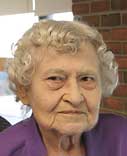While Irene Hess officially retired at age 70 in 1981, nearly every day she walks to work at the Institute for Social Research from her apartment near campus, the same place she has lived since coming to Ann Arbor.

So even though it was hot and humid, she walked to work as usual last Tuesday, wearing a deep purple dress. It was a special day for Hess, with a noon luncheon and symposium in her honor to mark the release of her fourth book U+00E2U+0080U+0093 an account of the practice of survey research at ISR starting in 1946, when the institute’s Survey Research Center (SRC) pioneered many of the principles and methods of conducting scientific population surveys.
At the age of 97, Hess is still very much on the job. In fact, there’s already talk of another book — one that will focus on some of the colorful personalities that Hess has worked with over the years. “I’m proud to have been a member of the team at the Survey Research Center,” she said to the large group of friends, colleagues and former students who gathered to celebrate her latest accomplishment and share a few memories and lessons she has taught them.
“We don’t have productivity standards for nonagenarians, but it looks like we will need to develop them,” says SRC Director Robert Groves, one of Hess’s former students and admirers.
Hess started her survey research career at the U.S. Census Bureau, where she helped to draw samples for large national surveys. At the time, probability sampling was a brand new field, and statisticians who knew how to draw valid national samples were in short supply. Hess was lured away from Washington by one of ISR’s founders, Leslie Kish, and arrived in Ann Arbor in 1954 to work at SRC.
During her 53 years at the center, Hess not only has helped shape the field of scientific survey sampling, she also served as a mentor and inspiration to many.
“She has a very broad fan club composed of some of the most distinguished social scientists from around the world,” says Steve Heeringa, another former student who is now director of the ISR Summer Program and the SRC Statistical Design Group.
“Under Irene’s supervision, every piece of work got checked, and everyone was involved in checking,” said James Lepkowski, who directs the ISR Program in Survey Methodology and who was a doctoral student first met Hess when she assigned him to do some of that checking. “I used to come back at night to pick up a book and Irene was always there, until 8 o’clock at least, typically checking over that day’s work one final time.”
“Irene has a deep interest in and devotion to scientific principles,” Groves said, “and she has always been committed to putting in the time necessary to produce the best possible work.

